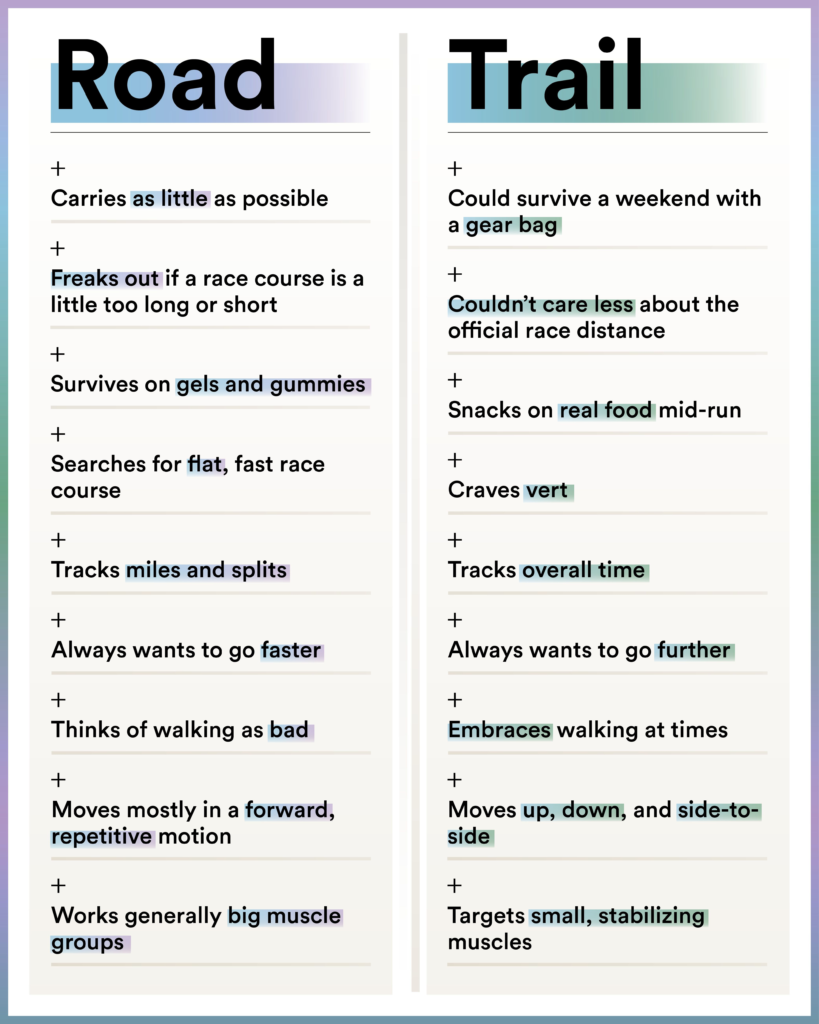When it comes to running, two distinct paths—literally and figuratively—emerge: trail running and road running. Each discipline offers a unique experience that caters to different preferences, environments, and fitness goals. Trail runners find themselves immersed in nature’s beauty, navigating uneven terrains under canopies of trees or alongside breathtaking vistas. On the other hand, road runners enjoy the rhythm of pavement beneath their feet as they clock miles along city streets or serene country roads.

Introduction to Trail Running and Road Running
Both styles come with their own set of benefits and challenges that shape every runner’s journey. Whether you’re contemplating switching things up or simply eager to learn more about these popular running disciplines, understanding trail vs. road running is essential for making informed choices about your fitness routine. So lace up those shoes! We’re diving into what makes each form of running special while weighing their respective advantages and hurdles. Ready? Let’s hit the trails—or should we say roads?
The Physical Differences Between the Two

Trail running and road running differ significantly in their physical demands.
Trail runners navigate uneven terrain, which engages a variety of muscle groups. This includes stabilizing muscles that help maintain balance on rocky or hilly paths. The varied elevation also puts extra strain on the calves and quads, enhancing strength over time.
On the other hand, road runners typically enjoy smoother surfaces. This creates a more consistent stride but may lead to repetitive stress injuries due to the uniformity of motion. Roads usually provide less cushioning than trails, impacting joint health differently.
Additionally, trail running often requires agility and quick reflexes to handle obstacles like roots or rocks. Road running emphasizes endurance—longer stretches at a steady pace are common here.
These distinct physical challenges contribute uniquely to each discipline’s overall experience and benefits for runners looking to diversify their training regimen.
Benefits of Trail Running
Trail running offers a refreshing escape from the monotony of pavement. The diverse terrain challenges your body differently, improving balance and agility with each stride.
Connecting with nature is another significant advantage. Running through forests, alongside rivers, or up mountains can elevate your mood and reduce stress levels. The sights and sounds of the outdoors create a unique experience that city running simply can’t match.
Moreover, trail running tends to be easier on your joints. Soft surfaces like dirt or grass absorb impact better than hard asphalt. This can lead to fewer injuries over time for those who regularly hit the trails.
It fosters a sense of community among outdoor enthusiasts. Many trails have clubs or organized runs, making it easy to meet fellow runners who share your passion for adventure in nature’s embrace.

Challenges of Trail Running
Trail running offers stunning vistas and a connection to nature, but it also presents unique challenges. Uneven terrain can be tough on the ankles and knees. Roots, rocks, and steep inclines demand constant attention.
Weather conditions add another layer of complexity. Rain can turn trails into slippery mudslides. Extreme temperatures may lead to dehydration or exhaustion.
Navigation is crucial in trail running. Getting lost in unfamiliar areas can be daunting for beginners. Properly reading maps or using GPS devices is essential for safety.
Additionally, wildlife encounters might surprise runners on remote paths. Knowing how to handle these situations becomes vital to enjoying the experience fully.
Finding suitable trails may require more effort than simply stepping outside your door for road running sessions. Planning ahead is key to ensuring an enjoyable outing without unexpected hurdles.
Benefits of Road Running
Road running offers a wealth of benefits that attract many fitness enthusiasts. One major advantage is accessibility. With paved paths and sidewalks readily available, it’s easy to lace up your shoes and hit the ground running.
Another perk is consistency in terrain. Road surfaces provide predictable footing, which can help you maintain rhythm and pace during your runs. This stability is especially beneficial for those training for races.
Additionally, road running often allows for greater social interaction. Many local communities host group runs or events that foster camaraderie among participants.
The convenience factor cannot be overlooked either; no need to travel far to discover new trails when city streets are right outside your door. Plus, road runners frequently experience less environmental exposure than trail enthusiasts do, making it easier to stick with their routine regardless of weather conditions.
In terms of training specifics, road running provides excellent opportunities to focus on speed work and interval training—essential elements for improving overall performance.
Challenges of Road Running

Road running presents a set of challenges that can test even the most seasoned runners. One significant issue is the monotony of pavement. Unlike trails, roads often lack variety in scenery and terrain, which can lead to boredom during longer runs.
Another challenge is the impact on your joints. The hard surfaces found on roads increase stress on knees and ankles, potentially leading to injuries over time.
Traffic also poses a risk. Runners must remain vigilant for vehicles, cyclists, and pedestrians while navigating city streets or suburban neighborhoods.
Weather conditions further complicate road running experiences. Rain, wind, or extreme heat can make it uncomfortable or even unsafe to hit the pavement.
Finding safe routes can be difficult in urban areas where sidewalks may be limited or poorly maintained. This factor necessitates planning ahead for varied training environments.
Choosing the Right Discipline for You
Choosing the right discipline often boils down to personal preferences and lifestyle. If you thrive on scenic views and a sense of adventure, trail running might be your calling. The unpredictable terrain can add excitement to every run.
On the other hand, if consistency and routine are what fuel your motivation, road running may suit you better. Paved paths provide a stable surface for tracking progress and improving speed.
Consider your goals as well. Are you aiming for long-distance races or simply looking to enjoy the outdoors? Each discipline caters to different aspirations.
Think about access. Do you live near trails or city streets? Your environment can significantly influence your choice between trail vs. road running. Listen to what excites you most—your passion will guide you toward the right path!
Tips for Transitioning from Road to Trail and Vice Versa
Transitioning from road to trail running requires some adjustments. Start by incorporating varied terrain into your training. Gradually introduce uneven surfaces, which will help build ankle strength and improve balance.
Invest in proper footwear. Trail shoes offer better grip and support compared to standard running shoes. This can significantly enhance your comfort on rugged paths.
When switching to road running, focus on pacing techniques. Roads typically allow for faster tempos, so practice maintaining a consistent speed over flat distances.
Don’t forget hydration strategies; trails may require different approaches due to longer stretches without water sources. Conversely, road routes often have more access points for quick refuels.
Listen to your body during the transition phase. It’s crucial not to push too hard or too fast in either discipline as you adapt. Embrace the journey of discovery while experimenting with new environments and challenges ahead!

Conclusion
Trail running and road running each offer unique experiences, challenges, and benefits. As you explore these two distinct disciplines, consider what resonates with your personal preferences and lifestyle. Whether you’re drawn to the serenity of nature on a trail or the rhythmic predictability of pavement, both forms of running can enhance your physical health and mental well-being.
Assessing the advantages—like improved strength and agility in trail running versus speed training in road running—can help inform your decision. Remember that every runner’s journey is different; it’s about finding joy in movement, regardless of where it takes place.
If you’re contemplating making a switch between trails and roads, embrace the change with an open mind. Each path offers its own rewards while challenging you in new ways. Listen to your body as you transition; this will guide you toward achieving optimal performance across various terrains.
Whether navigating rugged landscapes or smooth city streets, embracing either discipline can enrich your life through fitness adventures waiting just outside your door.
Stay tuned for more content, only on QAWire


